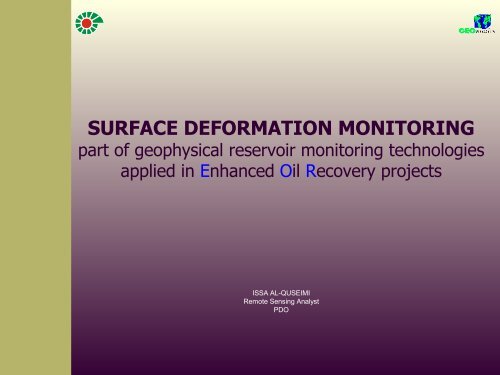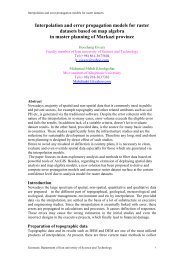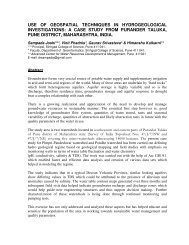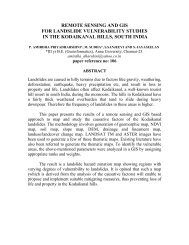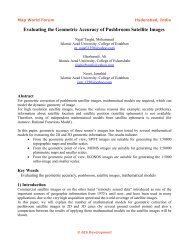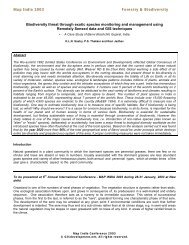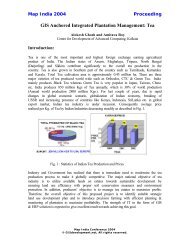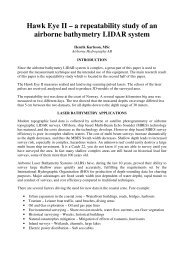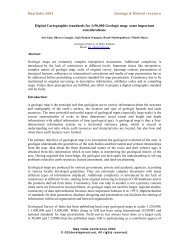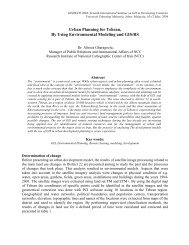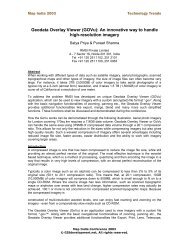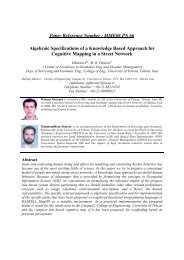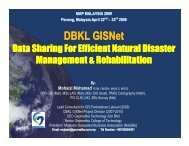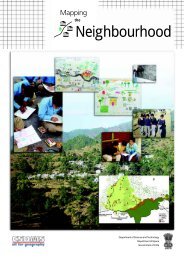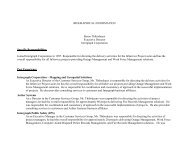SURFACE DEFORMATION MONITORING
SURFACE DEFORMATION MONITORING
SURFACE DEFORMATION MONITORING
Create successful ePaper yourself
Turn your PDF publications into a flip-book with our unique Google optimized e-Paper software.
<strong>SURFACE</strong> <strong>DEFORMATION</strong> <strong>MONITORING</strong><br />
part of geophysical reservoir monitoring technologies<br />
applied in Enhanced Oil Recovery projects<br />
ISSA AL-QUSEIMI<br />
Remote Sensing Analyst<br />
PDO
CURRENT & FUTURE GEOPHYSICAL<br />
<strong>MONITORING</strong> AREAS<br />
Steam Assisted<br />
GOGD in Light Oil<br />
Surfactant or<br />
Immiscible Flood<br />
Reservoir Depletion<br />
Steam in Fractured Carbonates<br />
Enhanced Oil<br />
Recovery projects<br />
are main PDO’s<br />
mid and long term<br />
strategy<br />
(Particularly<br />
steam injection<br />
projects)<br />
Steam in Sandstone<br />
‘Heavy Oil’
Objectives of Geophysical Reservoir Monitoring<br />
1. Map the 3D progression of the heat front<br />
2. Map expansion of the reservoir<br />
3. Identification of fracture/fault reactivation<br />
4. Measure stress changes in the caprock to<br />
assess caprock integrity<br />
Geophysical Monitoring Techniques includes;<br />
Micro Seismic.<br />
Surface Deformation.<br />
Time Lapse Seismic.
Surface Deformation Techniques<br />
Aims to detect deformation at the surface expressed<br />
as a change of slope, a horizontal movement, a<br />
subsidence, or an uplift.<br />
Surface measurements are carried out using ;<br />
<br />
<br />
<br />
<br />
Tiltmeter;<br />
Optical Precise Levelling;<br />
Precise Global Positioning System (GPS);<br />
Satellite Remote Sensing Radar technique known as<br />
Interferometric Synthetic Aperture Radar (InSAR)
Tiltmeter<br />
Advantage;<br />
• Can resolve tilt as small as one<br />
billionth of a radian<br />
corresponding to sub-millimeter<br />
precision across a typical array<br />
Disadvantage;<br />
• Too much sensitivity and too<br />
little long-term stability<br />
pick-up electrodes<br />
•Only Vertical Component.<br />
gas bubble<br />
X<br />
Y<br />
conductive liquid<br />
excitation electrode<br />
glas s cas e
Optical Precise Levelling (PL)<br />
Advantage;<br />
Sub/One millimeter Precision<br />
and most reliable<br />
Disadvantage;<br />
•HSE (Tedious under the sun)<br />
•Long time which might not<br />
be suitable for steam<br />
monitoring requirement<br />
• Only Vertical Component.
Precise GPS<br />
Advantage;<br />
•One to several millimeter Precision<br />
•both horizontal and vertical<br />
displacements<br />
•Faster than PL<br />
•Real Time Continuous Data<br />
Disadvantage;<br />
•Can be an HSE issue<br />
•Point Measure<br />
•Initially could be Costly
Interferometric Synthetic Aperture Radar<br />
(InSAR)<br />
Advantage;<br />
•Wide Area Coverage<br />
•Several millimeter Range Precision<br />
•100% Remote<br />
•Low Cost<br />
•Existing Database<br />
Disadvantage;<br />
•Atmospheric Errors
Optimum Surface Deformation Techniques<br />
GPS is reliable and the only technology to<br />
measure horizontal surface displacements<br />
-valuable additional information for reservoir<br />
monitoring.<br />
Combinations of GPS and InSAR processing<br />
are recommended to exploit the time-density of<br />
GPS data and the areal density of InSAR data
GPS/Levelling Comparison (2003-2005)
Qarn Alam InSAR Baseline Study
Mitigating Atmospheric InSAR Error<br />
InSAR corrected using GPS<br />
Uses the accuracy of GPS to propagate appropriate corrections to all<br />
nearby InSAR measurements<br />
Persistence Scatterers Synthetic Aperture Radar Interferometry (PSI)<br />
Uses a time series of SAR images to average-out atmospheric errors<br />
over every pixel with strong radar scattering properties<br />
Acknowledgements<br />
S tephen, Bourne (EPT-R HS )
Persistence Scatterers Synthetic Aperture<br />
Radar Interferometry (PSI)<br />
Standard InSAR Sep01/July04<br />
PS-InSAR Aug_2004/Aug2006
Recommendations<br />
•Options for reservoir monitoring should provide the right information<br />
at the right time. The quality of information depends on the areal<br />
coverage, density, and accuracy of surface displacement<br />
measurements.<br />
•Management of steam injection operation is a dynamic process<br />
-requires more frequent (i.e. every 2-3 months) observations and<br />
expected deformation is around 1-3 cm/year.<br />
•Recommend using combined InSAR and GPS techniques (every 2-3<br />
months). In addition, for wider aerial project coverage, PS InSAR<br />
technique is to be repeated once a year.
Fahud Implementation Strategy Plan<br />
SteamPhase1_2Year<br />
Heated Zone<br />
SteamPhase1<br />
Reservoir Model<br />
Rover Location<br />
Continuous Location


